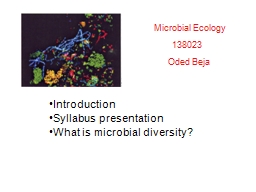

Oded Beja Introduction Syllabus presentation What is microbial diversity A twocredit course with one hour of lecture and one hour of discussion each week The course focuses on the microbial diversity of different environments ID: 1022657
Download Presentation The PPT/PDF document "Microbial Ecology 138023" is the property of its rightful owner. Permission is granted to download and print the materials on this web site for personal, non-commercial use only, and to display it on your personal computer provided you do not modify the materials and that you retain all copyright notices contained in the materials. By downloading content from our website, you accept the terms of this agreement.
1. Microbial Ecology138023Oded Beja•Introduction•Syllabus presentation•What is microbial diversity?
2.
3. A two-credit course with one hour of lecture and one hour of discussion each week.The course focuses on the microbial diversity of different environments. The objectives are:(1) to develop an understanding of the morphological, ecological,biochemical and evolutionary diversity of the microbial world;(2) to learn how microbes have evolved to survive under ‘extreme’ conditions; and(3) to learn the molecular biology and genomics methods by which this genetic diversity can be analyzed.
4. What is Microbial Diversity?Methods in microbial ecology.Phylogeny and evolutionFundamental similarities of all living organismsPaper presentation:Extremes of lifePhylogenetics and Trees of LifePaper presentation :Lateral gene transferMicrobial genomicsPaper presentation:What can we learn from genome sequences?Paper presentation:Complete GenomesEnvironmental Molecular MicrobiologyOverview of marine microbial ecologyMolecular Methods to assess microbial diversityPaper discussion:marine microbial diversityOligotrophy and VBNCPaper discussion:Bacterial Rhodopsin and phototrophy
5. Ecology of Extreme EnvironmentsExtremophiles and the Archaea:habitats and diversityPaper presentation:Yellowstone National ParkPaper presentation:Vent communitiesHyperthermophiles: phylogeny,morphology and physiologyGenome integrity in hyperthermophilesPaper presentation:DNA RepairThe flow of genetic information in hyperthermophilic ArchaeaPaper presentation :Protein thermostabilityPaper presentation:regulationAcidophiles:Sulfolobus and virusesPaper presentation:hyperthermophiles genetics
6. HalophilesHalophiles habitats and diversityHalophiles physiology,biochemistry and geneticsPaper presentation:HalophilesMarine ArchaeaPaper presentation:Cold ArchaeaPsychrophilesBiology of psychrophilesPaper presentation:Microorganisms of Antarctica
7. MethanogensMethanogenic Archaea and consortiaPhysiology of methanogenesis Paper presentation:MethanogensMicrobial photosynthesis and Novell photothrophsPaper presentation: aerobic anoxygenic phototrophsNovell EukaryotesPaper presentation: unsuspected eukaryotic diversityExobiologyPaper presentation: Magnetofossils from ancient Mars
8. 23/10/12 Introduction30/10/12 Phylogeny and evolutionWoese C.R. 2000 PNAS 97:8392-8396, Dunning Hotopp J.C. 2007 et al. Science 317:1753-17566/11/12 Microbial genomics13/11/12 Environmental Molecular Microbiology20/11/12 Ecology of Extreme Environments27/11/12 Hyperthermophiles: phylogeny, morphology and physiology4/12/12 Marine Archaea 11/12/12 Halophiles 18/12/12 Psychrophiles25/12/12 Microbial photosynthesis and Novell photothrophs 1/1/13 Novell Eukaryotes & New cultivation methods8/1/13 Exobiology
9. Microbial Diversity-cell shapes: rods, cocci, spirals, filaments,amorphous, pleomorphic, star-shaped, lumpy cocci, squares….-cell organization: multicellular from pairs andtetrads to filaments, sheets, rosettes, microbial mats,…-cells size: average 1 to 5 micronsrange 0.1 to 660 microns(Thiomargarita namibiensis , giant sulfur bacteruim inNamibian sediments)Morphological diversity
10. •Chemotrophs:energy is obtained from chemicals •lithotrophs:inorganic chemicals (sulfur, iron, hydrogen) -autotrophs: carbon is obtained by fixing CO2 (sulfur-reducing Archaea, methanogens) -heterotrophs: carbon is obtained from organic compounds (sulfur-reducing Archaea) •organotrophs and heterotrophs: carbon and energy are obtained from organic chemicals (heterotrophs, E.coli, pathogens)Metabolic diversity•Phototrophs: energy is obtained from light •heterotrophs:carbon is obtained from organic compounds (halophilic Archaea and others) •autotrophs: carbon is obtained by fixing CO2 (most cyanobacteria, photosynthetic bacteria)
11. Ecological diversity-salinity:from fresh water to marine and hypersalineenvironments (Dead sea and the Great Salt Lake, halophiles)-temperature: from –12 to 113oC (Pyrolobus) and beyond (121oC)-pH: from 0 (Thiobacillus thiooxidans) to 13 (Plectonemanostocorum) pH 0 is 1M HCl-redox potential: from –450mV (methanogens)to +850mV (iron bacteria)-hydrostatic pressure: from 1 to 1400 atm (barophiles)
12. Methods in microbial ecology
13.
14.
15.
16.
17.
18. Boetius et al. 2000Orphan et al. 2001
19.
20. Nanoarchaeum
21.
22.
23.
24.
25.
26.
27.
28.
29. Boetius et al. 2000Orphan et al. 2001
30.
31.
32. Paper presentation for next week:Woese C.R. (2000) PNAS 97:8392-8396Interpreting the universalphylogenetic tree